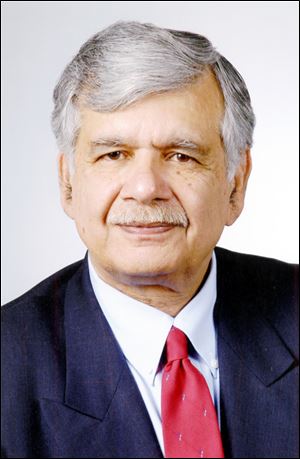
COMMENTARY
Pakistan’s Taliban peace talks a good strategy, but with little hope
3/17/2014
Hussain
Pakistan’s government is negotiating with the Taliban to end the reign of fear the terrorist organization has wrought on the country for seven years. You would think that giving legitimacy to a terrorist group would be against the tenets of a sovereign state. It is, however, a calculated strategy. It could work.
Encouraged by the success of the Taliban in next-door Afghanistan, militant religious groups in Pakistan’s border tribal areas have embarked on a path of violence to take over Pakistan’s government.
The Afghan Taliban rose from the ashes of a devastated country where a 20-year conflict — 10 years of fighting the occupying Soviet army, and then a bloody civil war — left Afghanistan exhausted and depleted. The Taliban brought welcome order to the country. They also brought and enforced harsh religious laws.
In Pakistan, civil society still exists. The army is intact, and is a highly disciplined institution committed to the constitution and territorial integrity of the country.
Support for the Taliban is not widespread in Pakistan. Since the ouster in 2008 of military dictator Pervez Musharraf, the country has gone through two successful cycles of parliamentary elections.
Terrorism, however, has taken a toll on Pakistan. Since 2001, terrorists have killed more than 45,000 Pakistanis — including more than 15,000 men and women in uniform. The economic impact of terrorism on Pakistan has been in excess of $68 billion.
The decision by Pakistan’s prime minister, Nawaz Sharif, to negotiate with the Taliban took many of his countrymen by surprise. In a shrewd political move, Mr. Sharif brought together all of the country’s political parties —ordinarily a fractious lot — to debate the merits of talks with the Taliban. They endorsed the idea.
Negotiations started a few months ago. The government demanded the cessation of terrorist attacks across the country. The Taliban agreed, but could not deliver.
Far from being cohesive, Tehrik-e-Taliban Pakistan is an organization of many splinter groups that usually are at odds with each other. Many smaller groups operate independently; they don’t feel obliged to agree with the parent organization.
This independence was evident in a string of suicide bombings across the country during the negotiations. Taliban forces slaughtered 23 kidnapped soldiers in Waziristan last month.
In retaliation, Pakistan’s air force bombed militants’ hideouts in Waziristan. That brought the Taliban running back to the table.
The Taliban do not recognize the constitution of Pakistan. The government insists that all negotiation be held within a constitutional framework.
For the Taliban, that would mean accepting the illegitimacy of its self-declared state of the Islamic Emirate of Waziristan, where the writ of the Pakistani government has given way to so-called Islamic laws, similar to Afghanistan in the 1990s.
There is a slim chance that negotiations between the Pakistani government and the Taliban will succeed. Mr. Sharif is banking on solid support across the political spectrum, in case negotiations fail and the army has to enter Waziristan, which is what the United States had been urging Pakistan to do for five years.
A military operation would be messy and difficult, not dissimilar to the cleanup operation the army undertook in the northern valley of Swat in 2009. The Taliban had infiltrated the valley and set up de facto rule.
In Swat, the Taliban shot teenager Malala Yousafzai in the head for standing up to them by asserting her right to get educated. She has become an activist for the education rights of youths, particularly young women, in Pakistan.
Battling the Taliban would be easier with the presence of North Atlantic Treaty Organization troops in Afghanistan. But with the expected departure of NATO forces from Afghanistan this year, any operation against the Taliban would be difficult.
On the treacherous road to peace in southeast Asia, there are many more turns ahead before light become visible at the end of the tunnel.
Dr. S. Amjad Hussain is a retired Toledo surgeon whose column appears every other week in The Blade.
Contact him at: aghaji@bex.net